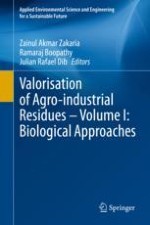2020 | OriginalPaper | Buchkapitel
3. Biological Treatment of Agro-Industrial Waste
verfasst von : Nur Izyan Wan Azelee, Nor Hasmaliana Abdul Manas, Daniel Joe Dailin, Aizi Nor Mazila Ramli, Shalyda Md Shaarani
Erschienen in: Valorisation of Agro-industrial Residues – Volume I: Biological Approaches
Aktivieren Sie unsere intelligente Suche, um passende Fachinhalte oder Patente zu finden.
Wählen Sie Textabschnitte aus um mit Künstlicher Intelligenz passenden Patente zu finden. powered by
Markieren Sie Textabschnitte, um KI-gestützt weitere passende Inhalte zu finden. powered by
